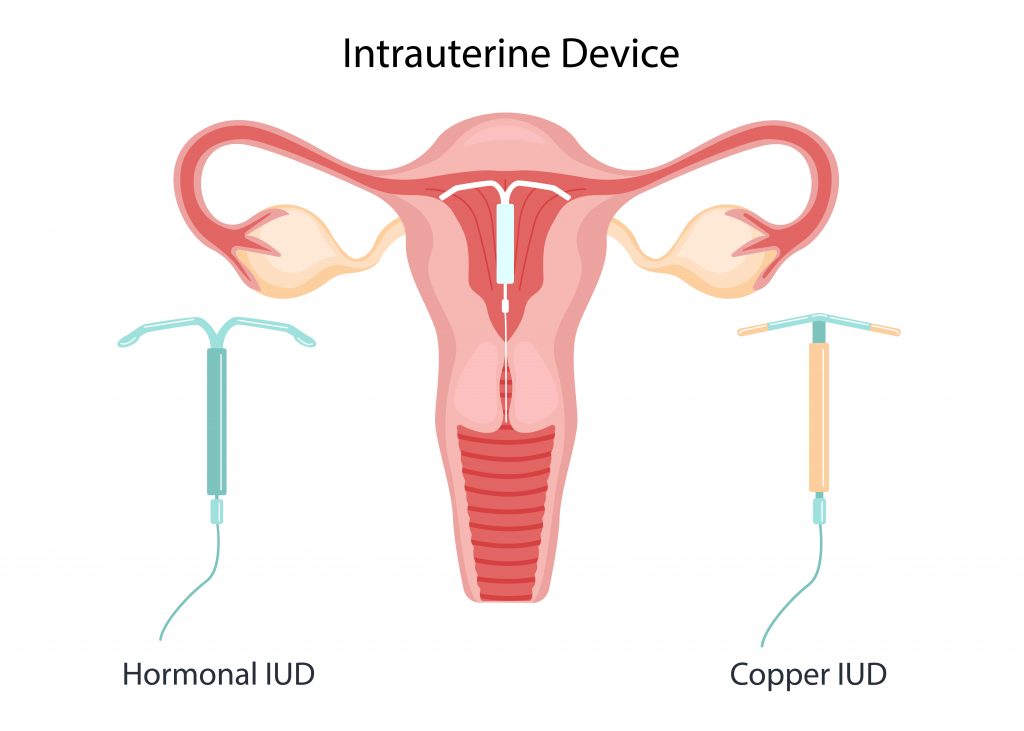Placing an IUD
We can advise you on both hormone-containing IUDs and copper IUDs. These methods are similar in terms of the shape of the device, but differ in their effect. IUDs are a very reliable method of contraception. It is important for us to know whether you have any infections (STDs) before the IUD is placed.
What is an IUD?
An IntraUterine Device (IUD) is a birth control device inserted into your uterus to prevent pregnancy. IUD’s are highly effective methods for preventing pregnancy. One of the advantages is that it’s al ong term birth controle and that it is reversible. There are different types of IUD’s possible, with each their advantages and disadvantages. At MC Wetering, we place both types of IUD’s.
Hormone-containing IUDs
The hormone-containing IUD releases a small amount of hormone every day and stays inside your uterus. It makes the lining of your uterus thin so you can’t get pregnant. The most commonly used hormone-containing IUD releases approximately 20μg levonorgestrel per day and acts primarily on the inside of the uterus. The IUD contains a depot with hormones and is T-shaped and just as long as it is wide (32 mm). The depot of levonorgestrel has a continuous release and can stay in your uterus up to 5 years. It can change your periods, sometimes making them lighter or even stopping them.
Copper-containing IUDs
A copper-containing IUD consists of a flexible frame with small arms and copper. There are various types of copper IUDs on the market. Copper IUDs work in different ways; the important thing is that a copper IUD ensures that the sperm cannot fertilize the ovum present. The copper IUD is suitable for every healthy woman. Copper-containing spirals can remain in place for at least 7-10 years. Advantages of copper IUDs for some women are that the copper IUD contains no hormones and that the woman retains her own cycle.
Placement of an IUD
It’s best to place the IUD during your period or within seven days after the first day of menstruation, because placement is sometimes easier then, and pregnancy may be excluded (minimum probability). Placement at another time is possible, but then we need to be sure that you are not pregnant. The IUD can be removed at any time. The copper IUD can also be placed as morning-after IUD within five days after unprotected sexual contact. You can take a painkiller one hour before placement to help with any discomfort. If you are not sensitive or allergic, we recommend 1 tablet Aleve Feminax 275 or 2 tablets of 500 mg paracetamol. It is also possible to numb the cervix before placement.
Removing an IUD
If you would like to remove your IUD, we can help you as well. Make an appointment with one of our gynaecologists to remove your IUD.

Frequently Asked Questions
How long does an IUD last?
How long an IUD lasts depends on the type of IUD. The hormone-containing IUD can stay in your uterus from 3 to 8 years. Copper-containing spirals can remain in place for at least 7-10 years.
How is an IUD inserted and removed?
The insertion of the IUD is always done by a trained gynaecologist or specialist. First, the position and depth of your cervix is measured. Then, the IUD is placed within your uterus with a tube like tool. This can cause pain and discomfort. The insertion will take about 10 minutes, but the full appointment will take longer. After your IUD is inserted, you may experience cramping and light spotting for a few days, although not everyone does. The removal of the IUD will also be done by a trained gynaecologist or specialist. The doctor will gently pull on the string that comes out of your uterus to pull the IUD out. The arms of the IUD will fold so that it can pass through the opening of your cervix. Removal of an IUD is often less painful than insertion.
Will an IUD affect my periods?
An IUD can affect your period, depending on which IUD you get. Hormone-containing IUD’s can change your periods, sometimes making them lighter or even stopping them. Copper IUD’s do not affect your period. As they contain no hormones, they do not affect your menstrual cycle.
How soon can I get pregnant after removing an IUD?
How soon you can get pregnant after removing your IUD differs per person. It is common to be able to get pregnant between 3 months and one year, but this timeline can differ for your personal situation. Please get in touch with one of our gynaecologists if you would like to get pregnant or have a pregnancy wish.
How do I check if my IUD is in place?
You can check if your IUD is still in place by feeling for the strings. Wash your hands and find a comfortable place to check. Insert your fingers into your vagina until you feel your cervix. You should be able to feel the string coming out of your cervix. Check whether it feels the same as last time you checked. If this is the case, the IUD is probably in the right place. Are you unsure whether your IUD is in place? You can make an appointment with our gynaecologists to let it get checked.
Waiting time indication
Dermatology
Days
Gynaecology
Days
Proctology
Days
Phlebology
Days
Plastic surgery
Days




